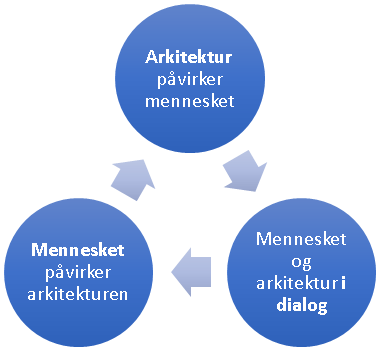Architectural Psychology at the Department of Psychology
with Professor Kaya Roessler
A human being cannot be indifferent to a place.  Places - whether we are talking about an entrance hall of a hospital, your office or a park in a city – all are characterized by a given lighting, certain acoustics and by their emotional impact on people. So, places can make people thrive or be unhappy, they can be experienced as fascinating, confusing or scaring. But at the same time, people give places a meaning. There is a difference between feeling stimulated, comfortable or insecure, and it is not always easy to find out what people's needs are in relation to a specific facility.
Places - whether we are talking about an entrance hall of a hospital, your office or a park in a city – all are characterized by a given lighting, certain acoustics and by their emotional impact on people. So, places can make people thrive or be unhappy, they can be experienced as fascinating, confusing or scaring. But at the same time, people give places a meaning. There is a difference between feeling stimulated, comfortable or insecure, and it is not always easy to find out what people's needs are in relation to a specific facility.
How the "built” world and nature affect people is the content of one of psychology's newer disciplines - architectural or environmental psychology. In the late 1940s, psychologists, human geographers, and sociologists began to develop the first theoretical concepts, and in the 1950s and 1960s, this discipline continued with specific psychological questions about how psychiatric hospitals in particular could be architecturally planned to support therapeutic work with anxious and stressed patients (Ittelson, 1960). Simultaneously with the research on hospitals, attention was extended to the more general relations between spaces, buildings and districts on the one hand and human needs on the other. In the 1970s and 1980s, the subject was established as an independent discipline (Altman & Wohlwil, 1977). The questions now became more general, e.g. how does we perceive our surroundings, what is place attachment, or which role does urban space or nature play for human health? The interplay between the man-made world around us and human behavior moved into the sphere of interest of academic psychology.
Architectural psychology, in English environmental psychology, has its research roots in the US, but also Sweden, Germany and England have contributed to the research process. Today, we find both basic and applied research in the field. Larger architectural firms in particular collaborate with the social sciences, and a tradition of user involvement is established, where user needs, and behaviour are analysed. Basic architectural psychological research, on the other hand, is interested in general laws in the interaction between man and the outside world. It includes perception and sensory impressions, but also thoughts about how our work and family lives change. Providing information and asking questions about the spatial organisation of work and leisure life is the future task of architectural psychology. Basically, we can take as our starting point three ways of approaching the relationship between man and architecture:

Architecture affects Human Beings
Here, architecture is central. Architecture affects the person who will adapt by having certain emotions and behaviour. For example is a church room, as architecture with high ceilings, an example of architecture that influences human beings. We are - depending on context and culture - uplifted, scared or silent. However, when architecture can affect, it can also become a tool for control. The philosopher Foucault has demonstrated this by analysing the panopticon, the 19th-century prison buildings. Through a universal visibility and potential surveillance, architecture becomes related to power.
Human Beings affect Architecture
Another starting point are human physical or mental needs. Here, people and their needs are central. The architect Le Corbusier (1887-1964) set up an idealised anthropometry, assumeing that all humans have the same organism and thus the same physiological needs. He developed a "machine à habiter", a living machine. This architectural psychological approach involves both opportunities and dangers. When one knows the needs of people, one can use this knowledge in the building process. Here, knowledge in psychology can become a tool - a stimulation - for human well-being. In some cases, architecture can become health-promoting or even healing, for example when constructing stress gardens. In particular, the human need for light is applied in the healing architecture, trying to support the healing process through architectural design.
Human Beings and architecture in dialogue
A third approach is based on the dynamic dialogue between humans and architecture. This dialogue provides active choices, opportunities but also ties. Architecture can be built as a flexible background for life processes, where flexibility is a principle. Walls can be moved, floors can be raised or lowered. The architect Mies van der Rohe created the "floating spaces", a space concept that was to provide freedom of movement, without fixed walls and doors.
Architectural psychology
Architectural psychology – is a elective subject at the Department of Psychology University of Southern Denmark. The classical, empirical psychology, which was founded by Wilhelm Wundt in 1871, used the "laboratory" - shielded from the physical environment. Laboratory studies are still used in psychology, and also architectural psychology uses experimental devices where a proband is tested in different physical environments. In the elective subject "Architectural Psychology" at the department in Odense, where we are trying to approach the connection between selected architectural areas (e.g. nature, learning environments, health related environments and psychology). The elective module works with three different scenarios: Architecture and health, nature and active living, as well as space and cultural identity
References:
Altman, I. & Wohlwill, J. (1977). Human behavior and environment. New York: Plenum.
Ittelson, W. (1960). Some factors influencing the design and functions of psychiatric facilities. Progress Report: Brooklin College.
A report on the first elective module in ”Architecture and Psychology” from 2014 kan be received by wirting a mail to: Kaya Roessler.
In the project Environmental Psychology work researcher from InCoRE Research Group.